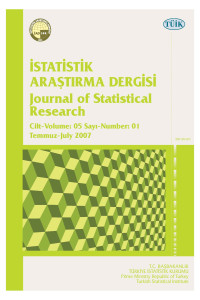Research Article
Year 2007,
Volume: 5 Issue: 1, 99 - 112, 13.07.2007
Abstract
Socio-economic differences between urban and rural areas are one of the important problems in Turkey. Population characteristics, natural resources, technologic developments, social and cultural structure must be considered during decision making processes and during any kind of policy making activities about rural areas for sustainable development. To achieve this goal, it is critical to determine socio-economic structure of the rural settlements. In this study, several socio-economic variables, which were obtained from TURKSTAT, were used to determine groups of provinces which represent similar rural characteristics by using hierarchical cluster analysis technique. The analyses were supported with dendrogram and agglomerative schedule. According to Ward method, Turkey has divided into eighteen groups in terms of rural socio-economic similarities. Initial results showed that neighboring provinces represent great similarity, but several other provinces, which are located at different geographical regions, also showed similar characteristics with each other. These findings represent contrast with the results of comparison of urban and rural characteristics together for Turkish provinces. Consequently, it can be said that the results of this study indicate that most of the rural areas are similar and differences are not significant in Turkey.
References
- Dinler, Z., 2001. Bölgesel İktisat. Ekin Kitabevi, Bursa.
- DPT, 2006a. Kırsal Kalkınma Politikaları Özel İhtisas Alt Komisyonu Raporu. Dokuzuncu Kalkınma Planı (2007–2013), Ankara.
- DPT, 2006b. Ulusal Kırsal Kalkınma Stratejisi. Ankara.
- Eminağaoğlu, Z. ve Çevik, S., 2007. Kırsal Yerleşmelere İlişkin Tasarım Politikaları ve Araçlar. Gazi Üniversitesi, Mühendislik Mimarlık Fakültesi Dergisi, 22(1), 157-162.
- Johnston, R., 1978. Multivariate Statistical Methods in Geography. Longman, London.
- Karabulut, M., Gürbüz, M., Sandal, E.K., 2004. Hiyerarşik Kümeleme Tekniği Kullanılarak Türkiye’de İllerin Sosyo-Ekonomik Benzerliklerinin Analizi. Coğrafi Bilimler Dergisi, Ankara Üniversitesi, Türkiye Coğrafyası Araştırma Ve Uygulama Merkezi, 2(2), 71-85.
- Koç, S., 2001. İllerin Sosyo-Ekonomik Özelliklere göre Sınıflandırılması. Çukurova Üniversitesi 5. Ulusal Ekonometri ve İstatistik Sempozyumu (Bildiri), Çukurova Üniversitesi, Adana.
- Mc Grew, J.C., Monroe, C.B., 1993. Statistical Problem Solving in Geography. WW C. Brown Publishers, Oxford-England.
- Şahin, H., 2002. Türkiye Ekonomisi. Ezgi Kitabevi, Bursa.
- Tolunay, A., Akyol, A., 2006. Kalkınma ve Kırsal Kalkınma: Temel Kavramlar ve Tanımlar. Süleyman Demirel Üniversitesi, Orman Fakültesi Dergisi, Seri A, 2, 116-127.
- TÜIK, 2002. 1997 Köy Envanteri, (Cd Ortamında- Excel Formatında).
- Ward, Jr. J. H., 1963. Hierarchical Grouping to Optimise an Objective Function. Journal of the American Statistical Associatin, 58, 236-244.
- Yenigül, S.B., 2006. Bölgesel Farklılıklar Açısından Kırsal Alanlar. IV. Ulusal Coğrafya Sempozyumu (25-26 Mayıs 2006) Bildiri Kitabı, 73-80, Ankara.
- Yılmaz, C., 2006. Türkiye’de Geri Kalmış Bölgelerin Kalkınmasında Kırsal Sanayinin Yeri ve Başlıca Sorunları. IV. Ulusal Coğrafya Sempozyumu (25-26 Mayıs 2006) Bildiri Kitabı, 255-264, Ankara.
Year 2007,
Volume: 5 Issue: 1, 99 - 112, 13.07.2007
Abstract
Ülkemizin en büyük sorunlarından biri kır ile kent yerleşmeleri arasındaki gelişmişlik farkıdır. Sürdürülebilir bir kalkınmanın sağlanabilmesi ve kır ile kent arası kalkınmışlık farkının giderilebilmesi için kırsal nüfusun demografik özellikleri ile doğal kaynaklar, ekonomik faaliyetler, sosyal ve kültürel yapı arasındaki dengenin her seviyedeki planlama ve politika geliştirme süreçlerinde göz önünde bulundurulması gerekmektedir. Bu araştırmada “Hiyerarşik Kümeleme Analizi” yöntemi kullanılarak, Türkiye’nin 81 ilinde, kırsal yerleşmelere ait Türkiye İstatistik Kurumu (TÜİK)’ten alınan 34 değişken yardımıyla, illerin kırsal potansiyelleri değerlendirilmiş, benzerlik özelliklerine göre kümeleme yapılmış ve bölgesel farklılıklar analiz edilmiştir. Sonuçlar “Dendrogram” ve “Aglomeratif Çizelge” ile de desteklenmiştir. Yapılan hesaplamalar sonucunda iller kırsal ölçekte benzerlik özelliklerine göre 18 kümeye ayrılmıştır. Genel olarak komşu iller birbirlerine daha çok benzerlik gösterirken, komşu olmayan ve farklı coğrafi bölgelerde yer alan bazı iller de kırsal özellikler bakımından benzerlikler göstermektedir. İllerin kır ve kent özellikleri beraber değerlendirildiğinde ortaya çıkan iller arası sosyo-ekonomik farklılıklar, kırsal ölçekteki sonuçlarla örtüşmemektedir.
References
- Dinler, Z., 2001. Bölgesel İktisat. Ekin Kitabevi, Bursa.
- DPT, 2006a. Kırsal Kalkınma Politikaları Özel İhtisas Alt Komisyonu Raporu. Dokuzuncu Kalkınma Planı (2007–2013), Ankara.
- DPT, 2006b. Ulusal Kırsal Kalkınma Stratejisi. Ankara.
- Eminağaoğlu, Z. ve Çevik, S., 2007. Kırsal Yerleşmelere İlişkin Tasarım Politikaları ve Araçlar. Gazi Üniversitesi, Mühendislik Mimarlık Fakültesi Dergisi, 22(1), 157-162.
- Johnston, R., 1978. Multivariate Statistical Methods in Geography. Longman, London.
- Karabulut, M., Gürbüz, M., Sandal, E.K., 2004. Hiyerarşik Kümeleme Tekniği Kullanılarak Türkiye’de İllerin Sosyo-Ekonomik Benzerliklerinin Analizi. Coğrafi Bilimler Dergisi, Ankara Üniversitesi, Türkiye Coğrafyası Araştırma Ve Uygulama Merkezi, 2(2), 71-85.
- Koç, S., 2001. İllerin Sosyo-Ekonomik Özelliklere göre Sınıflandırılması. Çukurova Üniversitesi 5. Ulusal Ekonometri ve İstatistik Sempozyumu (Bildiri), Çukurova Üniversitesi, Adana.
- Mc Grew, J.C., Monroe, C.B., 1993. Statistical Problem Solving in Geography. WW C. Brown Publishers, Oxford-England.
- Şahin, H., 2002. Türkiye Ekonomisi. Ezgi Kitabevi, Bursa.
- Tolunay, A., Akyol, A., 2006. Kalkınma ve Kırsal Kalkınma: Temel Kavramlar ve Tanımlar. Süleyman Demirel Üniversitesi, Orman Fakültesi Dergisi, Seri A, 2, 116-127.
- TÜIK, 2002. 1997 Köy Envanteri, (Cd Ortamında- Excel Formatında).
- Ward, Jr. J. H., 1963. Hierarchical Grouping to Optimise an Objective Function. Journal of the American Statistical Associatin, 58, 236-244.
- Yenigül, S.B., 2006. Bölgesel Farklılıklar Açısından Kırsal Alanlar. IV. Ulusal Coğrafya Sempozyumu (25-26 Mayıs 2006) Bildiri Kitabı, 73-80, Ankara.
- Yılmaz, C., 2006. Türkiye’de Geri Kalmış Bölgelerin Kalkınmasında Kırsal Sanayinin Yeri ve Başlıca Sorunları. IV. Ulusal Coğrafya Sempozyumu (25-26 Mayıs 2006) Bildiri Kitabı, 255-264, Ankara.
There are 14 citations in total.
Details
| Primary Language | Turkish |
|---|---|
| Subjects | Statistics |
| Journal Section | Research Articles |
| Authors | |
| Publication Date | July 13, 2007 |
| Published in Issue | Year 2007 Volume: 5 Issue: 1 |


